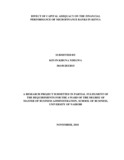| dc.contributor.author | Ndegwa, Kevin K | |
| dc.date.accessioned | 2019-01-25T07:37:51Z | |
| dc.date.available | 2019-01-25T07:37:51Z | |
| dc.date.issued | 2018 | |
| dc.identifier.uri | http://hdl.handle.net/11295/105546 | |
| dc.description.abstract | Regulated financial institutions are required to strictly adhere to the prescribed minimum statutory requirement on capital adequacy set by the regulator. The minimum standards on capital adequacy are set to ensure a stable and sound financial sector. The key concern for microfinance banks is ensuring that they meet the minimum required capital and also hold sufficient capital to compensate for the risks they are exposed to. This study sought to establish the effect of capital adequacy on the financial performance of microfinance banks in Kenya. The study adopted descriptive research design and the target population was thirteen microfinance banks in Kenya. The study period was for five years from 2013 to 2017. Secondary data was collected for only eight microfinance banks due to the availability of data for a five year period. A regression model (fixed effect model) was developed to determine the relationship between the dependent variable (financial performance) and the independent variable (capital adequacy) while the control variables used were asset quality, management efficiency, liquidity and size. The results indicated that the relationship between capital adequacy and ROA is positive and significant. Also, the relationship between size and ROA is shown to be positive but not significant. Liquidity and management efficiency are shown to have a negative and significant relationship with ROA. The study further show the relationship between asset quality and ROA to be negative and insignificant. The study concluded that capital adequacy, liquidity and management efficiency significantly affects financial performance of microfinance banks in Kenya while capital adequacy was found to have a positive relationship with financial performance. This indicates that the higher the capital held by a microfinance bank the higher the profitability. The study recommended that the microfinance banks’ regulator, CBK, ensure that all microfinance banks are well capitalized and meet the minimum capital adequacy ratios. | en_US |
| dc.language.iso | en | en_US |
| dc.publisher | University of Nairobi | en_US |
| dc.rights | Attribution-NonCommercial-NoDerivs 3.0 United States | * |
| dc.rights.uri | http://creativecommons.org/licenses/by-nc-nd/3.0/us/ | * |
| dc.subject | Microfinance Banks In Kenya | en_US |
| dc.title | Effect Of Capital Adequacy On The Financial Performance Of Microfinance Banks In Kenya | en_US |
| dc.type | Thesis | en_US |



